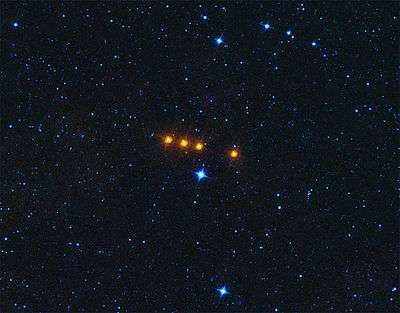31 Euphrosyne
Euphrosyne (minor planet designation: 31 Euphrosyne) is perhaps the 12th-largest asteroid in the asteroid belt, and possibly one of the half-dozen or so most massive. It was discovered by James Ferguson on September 1, 1854, the first asteroid found from North America. It is named after Euphrosyne, one of the Charites in Greek mythology. In 2019 a small companion was discovered.
 Three-dimensional model of 31 Euphrosyne created based on light-curve | |
| Discovery | |
|---|---|
| Discovered by | J. Ferguson |
| Discovery date | September 1, 1854 |
| Designations | |
| (31) Euphrosyne | |
| Pronunciation | /juːˈfrɒsɪniː/[1] |
Named after | Εὐφροσύνη Eyphrosynē |
| A907 GP; A918 GB | |
| Main belt | |
| Adjectives | Euphrosynean /juːfrɒsɪˈniːən/[2] |
| Orbital characteristics[3] | |
| Epoch April 27, 2019 (JD 2458600.5) | |
| Aphelion | 3.8523 AU (576.296 Gm) |
| Perihelion | 2.4585 AU (367.786 Gm) |
| 3.1554 AU (472.041 Gm) | |
| Eccentricity | 0.2209 |
| 5.61 yr (2041.585 d) | |
| 87.1671° | |
| Inclination | 26.3033° |
| 31.1186° | |
| 61.4704° | |
| Known satellites | 1 (6.7±2.4 km)[4] |
| Physical characteristics | |
| Dimensions | 267.08±2.61 km (IRAS)[3] |
| Mass | (5.81±1.97)×1019 kg[5][6] |
Mean density | 6.61 ± 2.41 g/cm³[5] |
| 0.2305 d (5.531 h)[3] | |
| 0.0543[7] | |
| C[3][8] | |
| 10.16[9] to 13.61 | |
| 6.74[3] | |
Observations
Euphrosyne is a fairly dark body near the belt's outer edge. Consequently, Euphrosyne is never visible with binoculars, having a maximum apparent magnitude at the best possible opposition of around +10.2 (as in November 2011), which is fainter than any of the thirty asteroids previously discovered.[10]
Euphrosyne has a high orbital inclination and eccentricity having nodes near perihelion and aphelion, Euphrosyne's perihelion lies at the northernmost point of its orbit. During perihelic oppositions, Euphrosyne is very high in the sky from northern latitudes and invisible from southern countries such as New Zealand and Chile.
Euphrosyne is very little studied but has been targeted by radar.[11] It is a C-type asteroid with a primitive surface. Its rotation period is typical for large asteroids. Nothing is known of its axial tilt.
Mass
The high mass estimate calculated by Baer et al. (2011), (5.81±1.97)×1019 kg, would make Euphrosyne the 5th- to 8th-most-massive asteroid, after the "big four" and within a standard deviation of 704 Interamnia, 511 Davida and 532 Herculina. However, the authors noted that their calculation – which was based on the perturbation of a single other asteroid – was suspect, as the high resulting density was inconsistent with a C-type asteroid. Nonetheless, the preliminary orbit later reported for the satellite is consistent with such a high mass.[12]
Satellite and family
Euphrosyne is the namesake of a complex family two thousand asteroids that share similar spectral properties and orbital elements. They are thought to have arisen from a collision. All members have relatively high orbital inclinations.[13]
In 2019 a small satellite was discovered, likely resulting from the same collisional event that created the family. Preliminary orbit computations indicated an orbital period of approximately 1.2 days and a semi-major axis of 677 km. The difference in absolute magnitude is 8.0 ± 0.8, implying a size ratio of 0.025±0.009 and thus a diameter of 6.7±2.4 km.[4]

References
- Noah Webster (1884) A Practical Dictionary of the English Language
- "Elia", The New-England Magazine, vol. IX, Oct. 1835, p. 236
- "JPL Small-Body Database Browser: 31 Euphrosyne" (2018-06-15 last obs). Retrieved 28 April 2019.
- Johnston, Wm. Robert (27 May 2019). "Asteroids with Satellites Database – (31) Euphrosyne". Johnston's Archive. Retrieved 4 June 2019.
The IAU circular, 'New satellite around (31) Euphrosyne', is available here and is copied here - Baer, James; Chesley, Steven R; Matson, Robert D (2011). "Astrometric Masses of 26 Asteroids and Observations on Asteroid Porosity". The Astronomical Journal. 141 (5): 143. Bibcode:2011AJ....141..143B. doi:10.1088/0004-6256/141/5/143.
- The mass of Euphrosyne is suspect. It was calculated from a single interaction with another asteroid, and is much greater than a C-type asteroid should be.
- Albedo table
- Astrometric and Geodetic Properties of Earth and the Solar System
- "Bright Minor Planets 2000". Minor Planet Center. Retrieved 23 May 2008.
- "Brightest asteroids". Archived from the original on 7 February 2012. Retrieved 6 August 2007.
- "Radar-Detected Asteroids and Comets". NASA/JPL Asteroid Radar Research. Retrieved 30 October 2011.
- The discovers of the satellite reported that "preliminary orbit computation indicates an orbital period of about 1.2 days for the satellite, with a semi-major axis of 677 km." That would indicate a mass in the range of 6.8×1019 kg.
- Novaković, Bojan; et al. (November 2011), "Families among high-inclination asteroids", Icarus, 216 (1), pp. 69–81, arXiv:1108.3740, Bibcode:2011Icar..216...69N, doi:10.1016/j.icarus.2011.08.016.
External links
- 31 Euphrosyne at AstDyS-2, Asteroids—Dynamic Site
- 31 Euphrosyne at the JPL Small-Body Database
